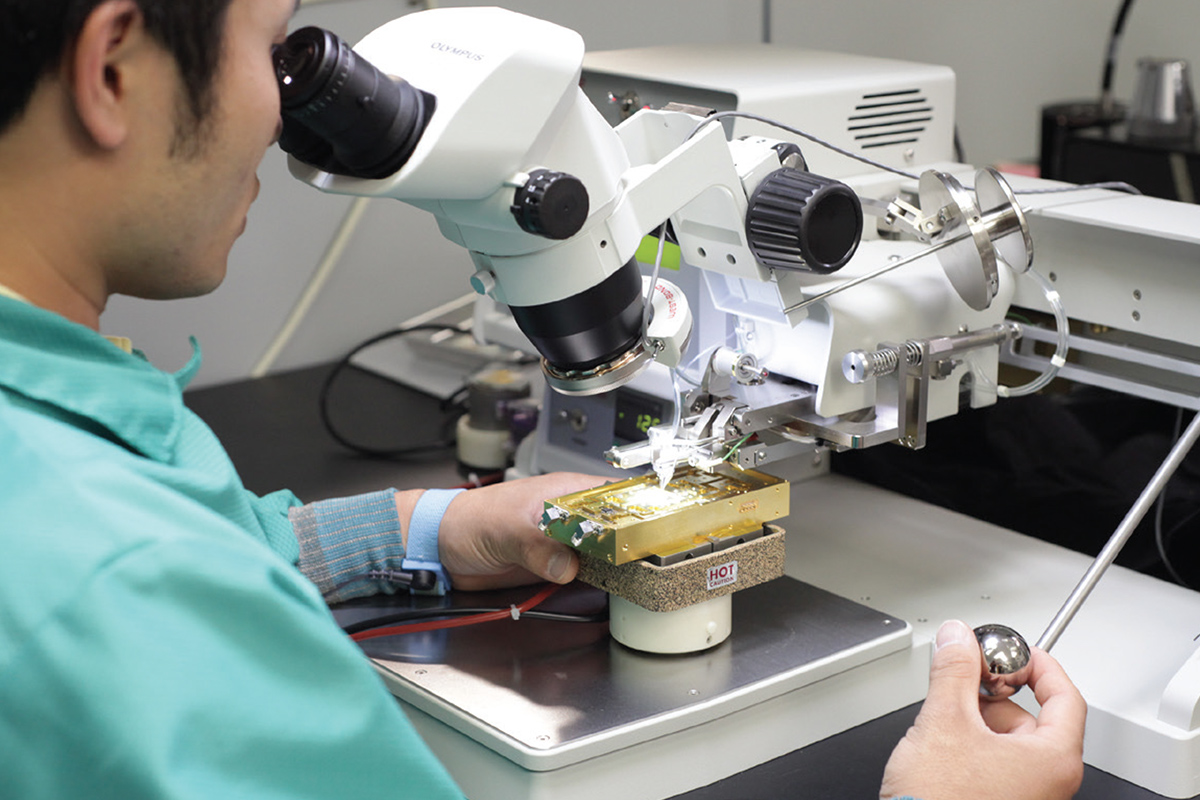Smaller Mesas and Faster Processing Requirements Necessitate Advanced RF/Microwave Wire Bonding Techniques

The advent of smaller mesas (sometimes < 40 microns) on microwave diodes and other devices, and the ongoing push for faster processing speeds and higher yields, have posed a number of wire bonding challenges to RF and microwave designers and manufacturing technicians alike. Overcoming these challenges requires not only the latest in wire-bonding equipment to accomodate descreasing wire diameters (< 1 mil), but the process development know-how, and specially designed tools to bond with the utmost efficiency. This topic is covered in-depth in our Tech Brief "Tips for Increasing Yields When Wire Bonding Small Mesa Chips", but in this blog we'd like to provide you a quick introduction to wire bonding and a few of the highlights from the brief.
Types of Wire-Bonding Technologies
Wire bonding is the technique of electrically and mechanically connecting the minute beam leads from integrated circuit (IC) die to larger packages, or directly to another substrate such as a PCB, with fine wire. Wire bonding is performed on over 40 million ICs every year, and is the dominant form of electrical IC bonding from die to package. Traditionally, 1 mil to 3 mil wire diameters were used but, more recently, sub-1 mil wires are increasingly being used to reduce the capacitive and inductive parasitics on RF integrated circuits (RFICs), monolithic microwave integrated circuits (MMICs), and high-speed digital chips.
A significant number of semiconductor device issues are attributed to wire bond failures. There are several wire bond methods that are employed, depending on the materials, costs, die type, application-specific needs, and customer needs. Among the various types are high-temperature thermocompression, which is largely used on aluminum (Al) wire bonding to Al or gold (Au) pad material. Room-temperature, ultrasonic welding is also used to bond Au and Al wire to Al or Au pad materials. Last of the common wire-bond techniques is thermosonic, which uses a combination of ultrasonic welding and thermocompression, and comprises over 90% of wire bonding.
Wire bonds are typically formed using ball bonds or wedge bonds. However, as the performance demands increase, wire sizes decrease, bond pads become smaller, and bond-pad spacing is reduced, ball bonds are becoming increasingly dominant as the bond-forming method employed. gold (Au) wire bonding to gold pads was the original method used when wire bonding was first developed, and it is still one of the most common materials used today. Aluminum (Al) wedge bonding is also used, as its lower cost appeals to certain applications. Nevertheless, aluminum wire can only be wedge-bonded, and can only be used when there is adequate bond-pad spacing. Copper (Cu) and silver (Ag) bond wire is also used, though they are far less common. This comparison table provides details on each bonding type.
|
Wire Bond Methods |
||||
|
Wire Bonding |
Operating Temperature |
Wire |
Pad |
Note |
|
Thermocompression |
300-500°C |
Au |
Al, Au |
High pressure, no ultrasonic energy |
|
Ultrasonic |
25°C |
Au, Al |
Al, Au |
Low pressure in ultrasonic energy |
|
Thermosonic |
100-240°C |
Au, Cu |
Al, Au |
Low pressure in ultrasonic energy |
Challenges of Working with Small MESA Devices
Quoting NASA,“Through the improvement of bonding technology the reliability of wire bonds is increasing, as is our understanding of the failure modes, though they continue to plague new manufacturing lines.” As any reduction in yield, or increase of cost and time associated with rework can have dramatic implications to the end cost of a product, improving yields on manufacturing lines largely comes down to the wire bonding process success. There are only a few typical wire bond failure modes that account for the large majority of wire bond failures. The failures range from bond wires peeling off the bond pad to wire bonds breaking during normal assembly and use.
One critical key to wire bonding success is the original manufacturer of the bonding equipment and tools, and their age and condition. There are many features available with the latest semi-automatic and automatic wirebonding machines that can dramatically increase yields, speed, and accuracy. An important one to look for is a wire bonding machine that enables ultra-precise dialing of the ultrasonic force. This is critical to ensuring high-quality rapid bonds. Many wire bonding experts rely on the latest Westbond wire bonding machines to maintain cutting-edge, wire bond capability. The precision and accuracy of these machines allow technicians to perform intricate wire bonds efficiently.
Another critical key is practice. By using sample parts and mounting to a bonding coupon, the wire bond process development can begin on a platform designed for continuous improvement. Through repetitive refinement, this process development mode can proceed until the process is repeatable and passes MIL-STD-883 requirements.
With extensive experience helping manufacturing centers prevent hundreds of thousands of dollars of loss, which can be attributed to ruined chips and reliability issues due to poor wire bonds, SemiGen experts are proficient with developing repeatable and value-added processes.
Contact us with any of your wire bonding questions.
To learn more, download our Tech Brief.


